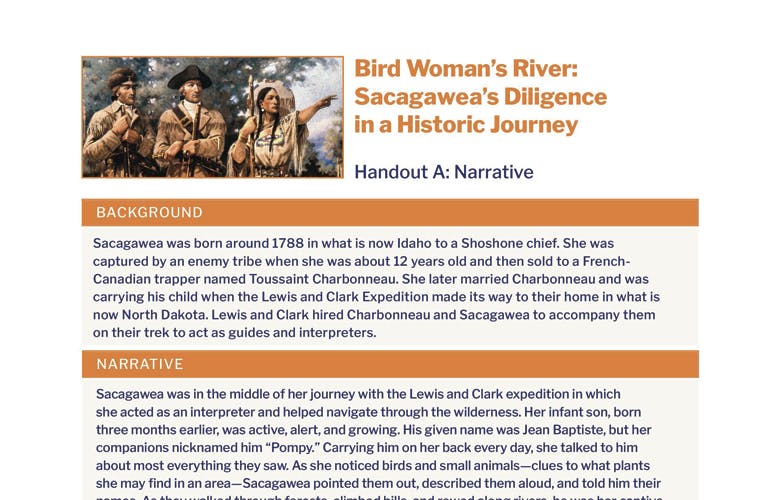Bird Woman’s River: Sacagawea’s Diligence in a Historic Journey – Handout A: Narrative
BACKGROUND
Sacagawea was born around 1788 in what is now Idaho to a Shoshone chief. She was captured by an enemy tribe when she was about 12 years old and then sold to a French Canadian trapper named Toussaint Charbonneau. She later married Charbonneau and was carrying his child when the Lewis and Clark Expedition made its way to their home in what is now North Dakota. Lewis and Clark hired Charbonneau and Sacagawea to accompany them on their trek to act as guides and interpreters.
NARRATIVE
Sacagawea was in the middle of her journey with the Lewis and Clark expedition in which she acted as an interpreter and helped navigate through the wilderness. Her infant son, born three months earlier, was active, alert, and growing. His given name was Jean Baptiste, but her companions nicknamed him “Pompy.” Carrying him on her back every day, she talked to him about most everything they saw. As she noticed birds and small animals—clues to what plants she may find in an area—Sacagawea pointed them out, described them aloud, and told him their names. As they walked through forests, climbed hills, and rowed along rivers, he was her captive audience.
Sacagawea was the wife of a member of Lewis and Clark’s Corps of Discovery. Born and raised in the territory they were exploring, she knew the terrain and the weather that awaited them. Sacagawea was undaunted by the unknown that lay ahead.
The Corps’ journey was the first American expedition into the uncharted western frontier. They were exploring territory unknown to previous citizens of the young United States. Its purpose was scientific, political, and grand: to discover a route to the Pacific Ocean and to record observations about the terrain, the flora, the fauna, the people they encountered along the way—and to establish friendly relations with those native nations. As they traveled, they sent journals and specimens back to President Jefferson so that the president and the young republic could learn about the western territory extending to the Pacific. Sacagawea served as a valuable member of the group, identifying edible and medicinal plants, recognizing geographic landmarks, and on at least one vital occasion, served as translator.
By the late spring of 1805, a full year into their journey, these rugged travelers may have been the most seasoned adventurers the world had ever known. Sacagawea helped explore terrain
that was both beautiful and intimidating. The group trekked beneath forest canopies in the humid summer and survived a long winter in the brutally cold Dakota Territory. Still, what they encountered on May 14, 1805 nearly devastated the expedition. If not for Sacagawea’s diligence in the wilderness, the group may have faced disaster.
The morning of Tuesday, May 14 was clear but cold. Some of the men’s moccasins, placed near the fire the night before, had frozen overnight. The thermometer showed 32 degrees. A wind blew from the southwest, and an icy fog hung over the river, a rare occurrence so late in the year.
The group was traveling the icy river and set out to continue their journey, Sacagawea and her husband Charbonneau were in a pirogue—a large rowboat with sails—that carried the important scientific equipment, journals, books (including a particularly valuable botany reference book), bullets, and medicine.
In the early evening a breeze picked up, and the men on Sacagawea’s boat lifted a sail to catch it. Suddenly, the wind began blowing even faster. With its sail up, the pirogue boat tipped. All the equipment and books began to wash overboard into the choppy river. While most panicked, Sacagawea remained calm. Clark described the sequence of events:
A squall of wind struck our sail broadside and turned the pirogue nearly over, and in this situation the pirogue remained until the sail was cut down, in which time she nearly filled with water—the articles which floated out was nearly all caught by the squaw who was in the rear. This accident had like to have cost us dearly; for in this pirogue were embarked our papers, instruments, books, medicine, a great proportion of our merchandise, and in short almost every article indispensably necessary to further the views, or insure the success of the enterprise, in which, we are now launched to the distance of 2,200 miles.
Sacagawea diligently sought to salvage the cargo most critical to the expedition by jumping into the icy river. Thanks to her actions, the scientific equipment, the journals, and Lewis’ revered botany reference book were recovered. In doing so, Sacagawea effectively saved the expedition.
Through most of her time with the Corps, Sacagawea was also the mother of an infant. As she trekked the difficult terrain, helped to navigate unfamiliar territory, and even rescued the expedition from failure, she was carrying her young son on her back. Even with that additional responsibility, her contributions—the result of her commitment and diligence—were vital to the success of that historic expedition.
Lewis wrote that “Sacagawea was as brave as anyone on the expedition.” To honor Sacagawea for her quick thinking and diligence, he and Clark named one of the Missouri River tributaries “Sacajawea.”
